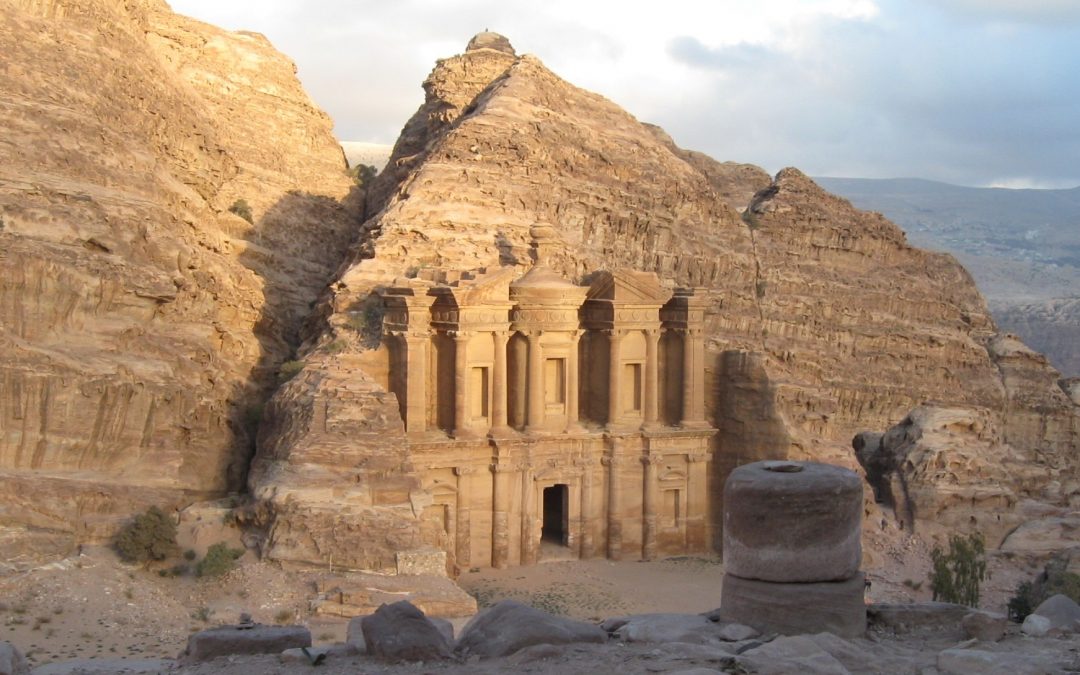Nicole Buckler visits Petra, the world’s most perfect ruin.
The most intriguing and stunning site in all of Jordan is the ancient lost city of Petra. It reverberates with the same energy today as it did when it was alive as a caravan city around 300 BC. It still has the power to stagger and disarm even the most seasoned and worldly traveller.
Perfect Petra
Petra – from the Greek meaning `rock’ — lies in an enormous deep desert valley about 80 kilometres south of the Dead Sea. Seeing the dead city for the first time proves to be more dramatic than any modern-day movie special effects. Strangely enough, the ancient city became widely known because of Hollywood’s fascination with the location.
Steven Spielberg put it on the world map when he set up camp and filmed the Indiana Jones flick, The Last Crusade, looking down into the Valley of Petra. Parts of Lawrence Of Arabia were also filmed at the same place. And, it’s easy to see why. It is as awesome, dusty and red in real life as it is on film. Of all the ruins and dead cities in the world, Petra retains its romance and emerges from the desert like a diamond in the rough pink sand. It is a little piece of gorgeousness in a savage, thirsty and harsh environment.

Al-Khazneh – The Treasury – is one of the most elaborate temples in the ancient Arab Nabatean Kingdom city of Petra. It was named the Treasury in the early 19th century by the area’s Bedouins, they believed it contained treasures.
The Siq
At the entrance to the site, you walk down a tiny gap in a wall of rock, which seems to go on forever. And, unexpectedly, the first, and most amazing building appears before you, between the rock walls. It is a beguiling and other-worldly experience.

The first glimpse of Petra’s Treasury upon exiting the Siq. The Siq is the main entrance to the ancient Nabatean city. It is a dim, narrow gorge which winds its way approximately 1.2 kilometres and ends at Petra’s most elaborate ruin, Al Khazneh.
Only opened to tourists in 1993, Petra is now awash with waves of visitors. The gates to the city open at 7am, and this is important to remember. It is in the early hours of the Jordanian morning that a visitor can soak up Petra in all its stillness. It is a surreal beauty in total peace. After about 9am, the tourist operators invade with their legions of followers. It is nearly impossible to get a photograph without the entire state of Texas in the frame. However, even with all the camera-happy crowds and the camel bandits, it feels completely still. Nothing can compete with its sheer magnificence. It’s worth fighting off the crowds to see every single beguiling part of it.

You can trek to the top of Petra in just two hours.
Nabatean Carving
The most fascinating thing about this city is that it wasn’t BUILT. It was CARVED by hand into the sides of the mountains that rise up vertically from the floor of the narrow Petra Valley. It is thought that a people called the Nabateans gouged the ancient city into life over 2000 years ago. Being prone to earthquakes, the area was left with many narrow but deep rifts. This gave the Nabateans a perfect blank slate to create the city.
The rocks consist of layer upon layer of swirling colours which provided the perfect palette. The Nabataeans exploited this in their architecture to magnificent effect. They perhaps used low-tech hand tools made of flint and iron, carving architectural masterpieces into the pink sandstone. It is thought they hung onto the ropes thrown over the top of the mountain. The carvers supported themselves mid-air while they created the amazing buildings.

Being in a valley, most of the architectural masterpieces of this ancient city have been protected from the sandstorms and the driving rain by the opposite mountain face. Still, the hand-carved façades are made of crumbly sandstone. Over the centuries these have gradually changed. Sculptures once depicting warriors and horses are now shaped by the weather into headless postmodern art. It would be worthy of putting in the middle of HOTA.
History of Petra
Little is known about Petra until about 300 BC when the Nabataeans, one of many Arab tribes, occupied it and made it the capital of their kingdom. It became a wealthy commercial empire that extended into Syria. Even less is known about the Nabataeans themselves. They were thought to be Arab desert nomads, who settled in this strategic location of the Great Rift Valley. In its heyday, the city was famous for two things: Its trade and its water engineering systems. It was the Nabataean knowledge of water management that allowed this city to flourish into a trading centre in the middle of Jordanian nowhere. Traders came to Petra to drink.

The system of aqueducts can still be seen today, 2000 years later. To produce water in a desert was the same as striking gold. This attracted camel caravans en route from trade centres such as China, India, Arabia and the Mediterranean. These traders came laden with spices, silk, and frankincense, and they brought a cosmopolitan nature to the people of Petra. And, the Nabateans got rich. Petra became a vital halting ground on the Spice Route.
The Nabatean civilisation flourished, acquiring goods in exchange for water and hospitality by the city’s residents. And, the safety of the city walls between mountains offered the caravans added protection. The Nabateans had the market sewn up – and they pumped the surplus riches into the carving of the astounding stone creations.

Invasions
The mounting riches of the Nabateans attracted the eyes of the Roman Empire. Of course, later in the century, they conquered Petra’s 3000 people. And soon enough, the architecture took on a distinctly Roman feel. However even the Romans could not stop the slow decline the city’s fortunes and its eventual demise. Shipping routes rose to greater prominence and rendered the overland route as uneconomical. Caravan routes shifted elsewhere. As a final nail in the coffin, a devastating earthquake had a severe impact on the city in 551 AD. It set Petra on the road to irretrievable ruin.
Petra became a backwater for the next 700 years. The nomadic Bedouin people kept its existence a closely-guarded secret from the outside world. It completely disappeared from most maps and was known only through ancient lore.
Rediscovery
Westerners became aware of Petra for the first time when it was rediscovered by the Swiss Explorer Johann Ludwig Burckhardt in 1812. Burckhardt had heard legends of the city during a visit to North Africa. He had the monumental advantage of being able to speak fluent Arabic. It occurred to him that myths surrounding the secret mountain enclave sounded a lot like the Petra, which ancient historians were calling “the lost city.” Burckhardt went on a mission to find it. He disguised himself as an Arab Muslim trader and hired a local guide. He knew that the Bedouins guarded the secret of the city’s location well. So he made up a story of needing to find Aaron’s tomb so as to sacrifice a goat, as he knew Aaron’s tomb to be in Petra.

Burckhardt rediscovered Petra, and only spent a day in the lost city, (much like modern tourists), not wanting to arouse the suspicion of his guides. However, he became the first westerner at Petra in seven centuries. Upon his return the west, he told the outside world about his discovery.
Bedouins in Petra
It is thought that the modern-day descendants of the Nabateans, who built Petra, are the Bedouins of Jordan. They are a desert people that still live a nomadic, tented life. Many of them, up to recently, still lived in Petra. However, wanting to develop Petra into the world’s most fantastic archaeological site, the Jordanian government relocated them. The Bedouins were evicted, having lived in Petra’s caves for thousands of years. The government set about building the Bedouins a village nearby. Even though they are officially displaced, the Bedouins return each day to do commerce with the tourists.

The Bedouin life certainly doesn’t strike a tourist as easy. Most sell Coca-Cola or jewellery or a ride on a withered donkey or a cranky, weary camel. I came across a little girl about four years old, selling colourful rocks that she had found. The fact that the ground around her was littered with the same rocks seemed of no relevance. To her, it was dignified way to beg.
Many tourists are reluctant to believe that the Bedouin people have been fully removed from Petra. Some fires can still be seen at night, and the ceilings of Petra’s stone buildings are blackened by campfire smoke.
Petra by Night

The most majestic time to see Petra is at night. The operators of the twilight tour run about pre-departure and put candles all throughout the entrance to the city, making the night walk a magical, eerie time to visit. After dark Petra is almost abandoned by tourists, bar a few scattered Bedouin families and their goats. Petra’s designation by UNESCO as a World Heritage Site reflects efforts to protect the city and its artefacts.
Ongoing excavations uncover more culturally delicious information on a daily basis, even as tourism swells at a steady pace. Amongst the ruins, archaeologists have identified 800 tombs, a market, a forum, shops, baths, and a huge Roman amphitheatre. The amphitheatre itself was painstakingly carved out of a mountain by hand. It is amazing to run up and down the seamless steps and enjoy the high-quality acoustics.
Petra isn’t just an archaeological wonder amidst startling desert scenery, it is also surely the world’s most perfect ruin.
Logistics
The best way to see Petra is to stay at one of the hotels at the entrance, in a little town called Wadi Musa. If you are religious, then you will believe that Moses led the Israelites through Wadi Musa on the way to the Promised Land. Remember, this is the desert, bring a lot of water and wear sensible shoes.
The best way to get to Petra is to fly into Amman airport, then it is a four-hour drive down a highway which has English signposting. You can get a public bus direct to Petra from Amman bus station, if you don’t want to hire a car or taxi.

Nicole Buckler, Editor-in-Chief
Author Bio: Nicole Buckler has been a journalist for over 20 years, working in Brisbane, Sydney, Melbourne, London, Dublin and Taipei. She recently returned to the Gold Coast, saying she has seen the world but the best place on earth is right here, and she’s never leaving again. You can contact her at Nicole@sunkissmedia.com.au

Editor for Silver Magazine Gold Coast

